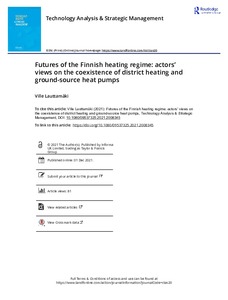Futures of the Finnish heating regime: actors’ views on the coexistence of district heating and ground-source heat pumps
Lauttamäki Ville
https://urn.fi/URN:NBN:fi-fe2022012710521
Tiivistelmä
The current Finnish heating regime is characterized by the strong position of district heating (DH). However, in recent years the DH regime has been challenged by the need to decarbonize energy production as well as intensified competition from new forms of heating, especially ground-source heat pumps (GSHPs). For the first time in decades, there is uncertainty about the future of DH. This paper investigates how the Finnish heating regime might change by 2030. Special attention is devoted to the coexistence of DH with GSHPs. Possible futures of the DH regime are examined using qualitative scenarios. The scenarios are based on the views of experts engaged in various heating demand and supply activities, including actors working with GSHPs. Development pathways identified in sustainability transitions studies are used as scenario frames. The research yielded three plausible scenarios for the potential future development of the DH regime in Finland and the role of GSHPs in these futures. In a scenario that was seen as the most probable, DH companies maintain their position but change their operational logic. Heat production shifts from highly centralized to more distributed production, and the role of DH companies changes from being energy producers to administrators of heat flows.
Kokoelmat
- Rinnakkaistallenteet [27094]
